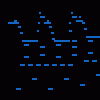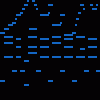No comments yet
Beethoven - Moonlight Sonata No. 14, Op. 27 No. 2, Mvt. 1
The Piano Sonata No. 14 in C-sharp minor, marked Quasi una fantasia, Op. 27, No. 2, is a piano sonata by Ludwig van Beethoven, completed in 1801 and dedicated in 1802 to his pupil Countess Julie "Giulietta" Guicciardi. Although known throughout the world as the Moonlight Sonata (German: Mondscheinsonate), it was not Beethoven who named it so. The name grew popular later, likely long after Beethoven's death.
The piece is one of Beethoven's most famous compositions for the piano, and was quite popular even in his own day. Beethoven wrote the Moonlight Sonata around the age of 30, after he had finished with some commissioned work; there is no evidence that he was commissioned to write this sonata.
The first movement, in C♯ minor and alla breve, is written in modified sonata-allegro form.
The movement opens with an octave in the left hand and a triplet figuration in the right. A melody that Hector Berlioz called a "lamentation", mostly by the left hand, is played against an accompanying ostinato triplet rhythm, simultaneously played by the right hand. The movement is played pianissimo (pp) or "very quietly", and the loudest it gets is piano (p) or "quietly".
The adagio sostenuto tempo has made a powerful impression on many listeners; for instance, Berlioz commented that it "is one of those poems that human language does not know how to qualify". Beethoven's student Carl Czerny called it "a nocturnal scene, in which a mournful ghostly voice sounds from the distance". The movement was very popular in Beethoven's day, to the point of exasperating the composer himself, who remarked to Czerny, "Surely I've written better things".
The piece is one of Beethoven's most famous compositions for the piano, and was quite popular even in his own day. Beethoven wrote the Moonlight Sonata around the age of 30, after he had finished with some commissioned work; there is no evidence that he was commissioned to write this sonata.
The first movement, in C♯ minor and alla breve, is written in modified sonata-allegro form.
The movement opens with an octave in the left hand and a triplet figuration in the right. A melody that Hector Berlioz called a "lamentation", mostly by the left hand, is played against an accompanying ostinato triplet rhythm, simultaneously played by the right hand. The movement is played pianissimo (pp) or "very quietly", and the loudest it gets is piano (p) or "quietly".
The adagio sostenuto tempo has made a powerful impression on many listeners; for instance, Berlioz commented that it "is one of those poems that human language does not know how to qualify". Beethoven's student Carl Czerny called it "a nocturnal scene, in which a mournful ghostly voice sounds from the distance". The movement was very popular in Beethoven's day, to the point of exasperating the composer himself, who remarked to Czerny, "Surely I've written better things".
0 Comments
No comments yet
Link to this sequence: 3583654
Simple
Advanced
Synthesizer
Instrument name
Copy
Load
Clone
Delete
Mute
Solo
Reset
Volume
Delay
Panning
Detune
Reverb
Distort
Equalizer
High
Mid
Low
Bitcrusher
Synthesizer
Resonance (Q)
LFO
1/4
Envelope
A
D
S
R
BPM
Title
Instrument
- Select/deselect notes
- Select/deselect markers
- Save a copy
- Save offline
- Export MP3
- Export WAV
- Export MIDI
- Import MIDI/Sequence File
- Fast graphics
- Invert
- Minor ⇄ Major
- Reverse Selection
- Humanize Selection
- Legatomize Selection
- Fade In Selection
- Fade Out Selection
- Stretch Selection
0
Connect a MIDI keyboard.
Record keyboard and MIDI inputs.
Snap recorded notes to the grid.
Filter recorded notes using the key guide.
Play a metronome. When recording, gives a 4 beat lead in.
OnlineSequencer.net is an online music sequencer. Make tunes in your browser and share them with friends!
Made by Jacob Morgan and George Burdell
·
Hosting 4,550,595 sequences since 2013 ·
Buy us a ☕ ·
Privacy
·













